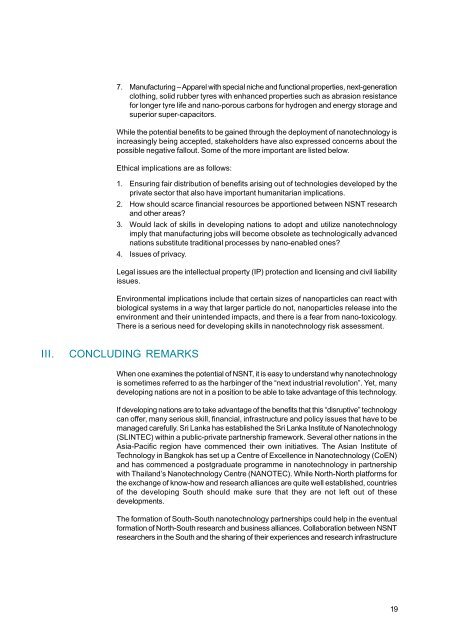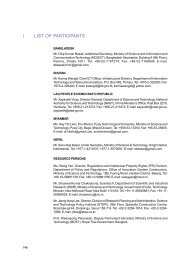innovation in nanotechnology an asia-pacific perspective - apctt
innovation in nanotechnology an asia-pacific perspective - apctt
innovation in nanotechnology an asia-pacific perspective - apctt
You also want an ePaper? Increase the reach of your titles
YUMPU automatically turns print PDFs into web optimized ePapers that Google loves.
7. M<strong>an</strong>ufactur<strong>in</strong>g – Apparel with special niche <strong>an</strong>d functional properties, next-generation<br />
cloth<strong>in</strong>g, solid rubber tyres with enh<strong>an</strong>ced properties such as abrasion resist<strong>an</strong>ce<br />
for longer tyre life <strong>an</strong>d n<strong>an</strong>o-porous carbons for hydrogen <strong>an</strong>d energy storage <strong>an</strong>d<br />
superior super-capacitors.<br />
While the potential benefits to be ga<strong>in</strong>ed through the deployment of <strong>n<strong>an</strong>otechnology</strong> is<br />
<strong>in</strong>creas<strong>in</strong>gly be<strong>in</strong>g accepted, stakeholders have also expressed concerns about the<br />
possible negative fallout. Some of the more import<strong>an</strong>t are listed below.<br />
Ethical implications are as follows:<br />
1. Ensur<strong>in</strong>g fair distribution of benefits aris<strong>in</strong>g out of technologies developed by the<br />
private sector that also have import<strong>an</strong>t hum<strong>an</strong>itari<strong>an</strong> implications.<br />
2. How should scarce f<strong>in</strong><strong>an</strong>cial resources be apportioned between NSNT research<br />
<strong>an</strong>d other areas?<br />
3. Would lack of skills <strong>in</strong> develop<strong>in</strong>g nations to adopt <strong>an</strong>d utilize <strong>n<strong>an</strong>otechnology</strong><br />
imply that m<strong>an</strong>ufactur<strong>in</strong>g jobs will become obsolete as technologically adv<strong>an</strong>ced<br />
nations substitute traditional processes by n<strong>an</strong>o-enabled ones?<br />
4. Issues of privacy.<br />
Legal issues are the <strong>in</strong>tellectual property (IP) protection <strong>an</strong>d licens<strong>in</strong>g <strong>an</strong>d civil liability<br />
issues.<br />
Environmental implications <strong>in</strong>clude that certa<strong>in</strong> sizes of n<strong>an</strong>oparticles c<strong>an</strong> react with<br />
biological systems <strong>in</strong> a way that larger particle do not, n<strong>an</strong>oparticles release <strong>in</strong>to the<br />
environment <strong>an</strong>d their un<strong>in</strong>tended impacts, <strong>an</strong>d there is a fear from n<strong>an</strong>o-toxicology.<br />
There is a serious need for develop<strong>in</strong>g skills <strong>in</strong> <strong>n<strong>an</strong>otechnology</strong> risk assessment.<br />
III. CONCLUDING REMARKS<br />
When one exam<strong>in</strong>es the potential of NSNT, it is easy to underst<strong>an</strong>d why <strong>n<strong>an</strong>otechnology</strong><br />
is sometimes referred to as the harb<strong>in</strong>ger of the “next <strong>in</strong>dustrial revolution”. Yet, m<strong>an</strong>y<br />
develop<strong>in</strong>g nations are not <strong>in</strong> a position to be able to take adv<strong>an</strong>tage of this technology.<br />
If develop<strong>in</strong>g nations are to take adv<strong>an</strong>tage of the benefits that this “disruptive” technology<br />
c<strong>an</strong> offer, m<strong>an</strong>y serious skill, f<strong>in</strong><strong>an</strong>cial, <strong>in</strong>frastructure <strong>an</strong>d policy issues that have to be<br />
m<strong>an</strong>aged carefully. Sri L<strong>an</strong>ka has established the Sri L<strong>an</strong>ka Institute of N<strong>an</strong>otechnology<br />
(SLINTEC) with<strong>in</strong> a public-private partnership framework. Several other nations <strong>in</strong> the<br />
Asia-Pacific region have commenced their own <strong>in</strong>itiatives. The Asi<strong>an</strong> Institute of<br />
Technology <strong>in</strong> B<strong>an</strong>gkok has set up a Centre of Excellence <strong>in</strong> N<strong>an</strong>otechnology (CoEN)<br />
<strong>an</strong>d has commenced a postgraduate programme <strong>in</strong> <strong>n<strong>an</strong>otechnology</strong> <strong>in</strong> partnership<br />
with Thail<strong>an</strong>d’s N<strong>an</strong>otechnology Centre (NANOTEC). While North-North platforms for<br />
the exch<strong>an</strong>ge of know-how <strong>an</strong>d research alli<strong>an</strong>ces are quite well established, countries<br />
of the develop<strong>in</strong>g South should make sure that they are not left out of these<br />
developments.<br />
The formation of South-South <strong>n<strong>an</strong>otechnology</strong> partnerships could help <strong>in</strong> the eventual<br />
formation of North-South research <strong>an</strong>d bus<strong>in</strong>ess alli<strong>an</strong>ces. Collaboration between NSNT<br />
researchers <strong>in</strong> the South <strong>an</strong>d the shar<strong>in</strong>g of their experiences <strong>an</strong>d research <strong>in</strong>frastructure<br />
19



